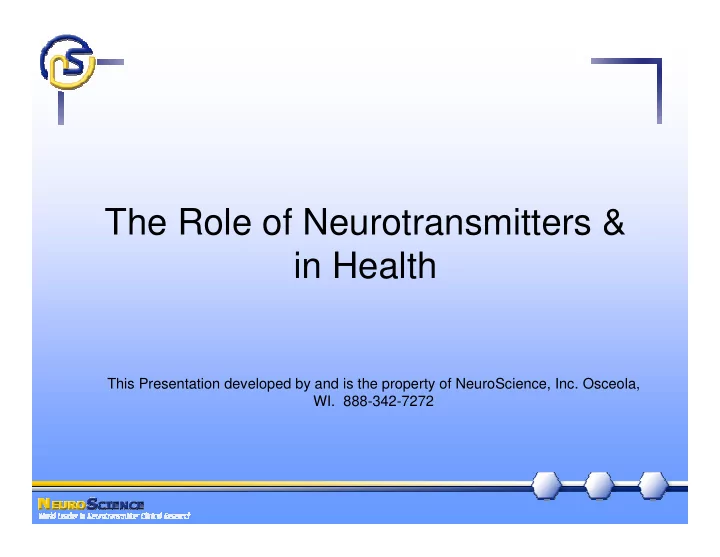

The Role of Neurotransmitters & in Health This Presentation developed by and is the property of NeuroScience, Inc. Osceola, WI. 888-342-7272
Questions to Answer • Why should we be concerned about neurotransmitters? What are they? • Are they critical to our health? • What is their contribution to clinical conditions?
What are Neurotransmitters? • Chemicals that serve as messengers between the brain and organs. • Analogous to the body’s internal telephone system. • Must have adequate levels to be healthy!
Why are they important? • Without neurotransmitters, your brain could not tell: – Your heart to beat – Your lungs to breath – Your stomach to digest
Neurotransmitters Affect the ENTIRE Human Being Emotionally •Mood •Behavior •Social attitude Physically Mentally •Sleep •Focus •Cardiac Function •Learning •Metabolism/Weight ability
Neurotransmitter Imbalances • Scientific studies suggest the incidence of neurotransmitter imbalances in the population is very high.
Serotonin in the Patient Population N=20000 600 500 400 (ug/gCr) 300 200 100 0 0 10 20 30 40 50 60 70 80 90 Age
Where do Imbalances Come From? • High levels of stress • Poor dietary habits • Neurological toxins • Genetics
Where do Imbalances Come From? • Stressful lifestyles cause the body to lose neurotransmitters rapidly, which leads to very low levels over time.
Where do Imbalances Come From? • Poor dietary habits (fast-food, junk food, sugars, etc.) do not provide the body with the building blocks for neurotransmitters, called amino acids.
Where do Imbalances Come From? • Neurological toxins, such as industrial cleaners, air & water pollution, and heavy metals disrupt neurotransmission and kill brain cells, which contain the neurotransmitters.
Where do Imbalances Come From? • Some people have poor neurotransmitter levels due to their genetics.
Neurotransmitter Imbalances Have Been Linked to: • Insomnia • ADD/ADHD/Autism • Weight Problems • Anxiety • Depression • OCD • Fatigue • Behavioral Issues • Migraines • Others
Neurotransmitter Function • Neurotransmitters are divided into two categories: • Inhibitory • Excitatory – Calming – Energizing – Relaxing – Motivating – Sleep inducing – Provide focus – Slow down the – Rev up the system system
Excitatory/Inhibitory Classification Excitatory NT’s Inhibitory NT’s Glutamate GABA Epinephrine Serotonin Norepinephrine Glycine PEA Taurine Histamine Dopamine Aspartic Acid Agmatine Dopamine
Neurotransmitters & Sleep Sleep disturbances can be due to a number of different neurotransmitter & hormone imbalances. 3 AM Sample Optimal Range Pt. 1 Pt. 2 Pt. 3 Pt. 4 Pt. 5 Pt. 6 (nighttime) Insomnia Pt’s. Epinephrine <5 15.6 3.2 1.5 2.7 3.0 1.1 Norepinephrine 30-55 36.8 77.5 21.0 25.4 27.4 31.2 Dopamine 125-175 159 123 178 158 174 126 Serotonin 175-225 145 96.3 87.5 74.2 100 65.2 GABA 2.0-4.0 4.3 5.2 4.1 6.7 5.9 2.1 PEA 175-350 199 289 895 333 208 177 Histamine 10-25 13.1 22.8 11.4 47.2 19.5 15.2 Cortisol 0.3-1.5 0.9 1.1 1.5 0.5 6.4 1.8 Melatonin 25-60 46 26 34 36 21 6.4
Neurotransmitters & Sleep • Trends associated with sleep disturbances: – Low serotonin levels – Elevated levels of one or more excitatory neurotransmitters – Hormonal imbalances: • Low melatonin • High cortisol
What can be done? • Identifying which chemical is out of balance is the first step. • A non-invasive hormone & neurotransmitter test can identify if there is an imbalance in the system. • Once the imbalance has been identified, a targeted therapeutic regimen can be developed.
What can be done? • Healthy lifestyle choices can improve neurotransmitter & hormone levels, leading to better sleep patterns. – Eat a healthy diet, avoiding foods high in sugars – Exercise – Avoid environmental toxins – Develop a consistent sleep schedule
Benefits of a Healthy Diet • Neurotransmitters are made from protein- containing foods in our diet. • Sugar can lead to depletion of certain neurotransmitters. • Avoiding large amounts of sugar helps prevent the rapid loss of neurotransmitters that eventually leads to low levels.
Benefits of Exercise • Exercise raises the levels of many neurotransmitters, including serotonin. • Exercise during the day has been scientifically shown to help people sleep more soundly.
Case Study • Chronic insomnia Female, 46 Y.O. Optimal Range 1 st 2 nd (nighttime) patient, unable to 10 PM Sample Test Test Epinephrine <5 9.6 fall asleep on a Norepinephrine 30-55 46.3 nightly basis. Dopamine 125-175 159 Serotonin 175-225 63 GABA 2.0-4.0 5.0 PEA 175-350 637 • Elevated PEA & Histamine 10-25 24.7 epinephrine, and Cortisol 0.3-1.5 1.3 low serotonin are Melatonin 25-60 36 likely causes.
Case Study • Patient began Female, 46 Y.O. Optimal Range 1 st 2 nd (nighttime) Targeted Amino 10 PM Sample Test Test Epinephrine <5 9.6 Acid Therapy Norepinephrine 30-55 46.3 program Dopamine 125-175 159 Serotonin 175-225 63 designed to raise GABA 2.0-4.0 5.0 serotonin and PEA 175-350 637 lower PEA & Histamine 10-25 24.7 Cortisol 0.3-1.5 1.3 epinephrine. Melatonin 25-60 36
Case Study • After 3 months of Female, 46 Y.O. Optimal Range 1 st 2 nd (nighttime) therapy, the 10 PM Sample Test Test Epinephrine <5 9.6 4.8 neurotransmitter Norepinephrine 30-55 46.3 39.8 values have Dopamine 125-175 159 141 Serotonin 175-225 63 305 normalized and GABA 2.0-4.0 5.0 4.6 the patient was PEA 175-350 637 369 able to fall asleep Histamine 10-25 24.7 23.7 Cortisol 0.3-1.5 1.3 0.9 regularly. Melatonin 25-60 36 44
Summary • Sleep is a complex biological process that is influenced by many neuroendocrine parameters. • A disruption in one or more of these parameters can lead to sleep disturbances. • Identifying which chemical is out of balance is the first step in addressing sleep problems.
Summary • Supplying the body with the building blocks (amino acids) for making neurotransmitters is a natural, effective alternative to addressing sleep related problems.
Recommend
More recommend